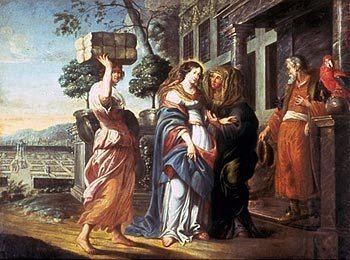Related Movements 10 in two parts | Chorale by Martin Jahn | |
 | ||
Cantata text Salomo Franckanonymous | ||
Herz und Mund und Tat und Leben (Heart and mouth and deed and life), BWV 147, is a church cantata by Johann Sebastian Bach. It was written originally in Weimar in 1716 (BWV 147a) for Advent and expanded in 1723 for the feast of the Visitation in Leipzig, where it was first performed on 2 July 1723.
Contents
History and words
Bach composed the cantata in his first year as Thomaskantor in Leipzig for the Marian feast "Mariae Heimsuchung" (Visitation). The prescribed readings for the feast day were Isaiah 11:1–5, the prophecy of the Messiah, and from the Gospel of Luke, Luke 1:39–56, Mary's visit to Elizabeth, including her song of praise, the "Magnificat". He used as a base a cantata in six movements composed in Weimar for the fourth Sunday in Advent. As Leipzig observed tempus clausum (time of silence) from Advent II to Advent IV, Bach could not perform the cantata for that occasion and rewrote it for the feast of the Visitation. The original words were suitable for a feast celebrating Mary in general; more specific recitatives were added, the order of the arias changed, and the closing chorale was replaced and repeated on a different verse to expand the cantata to two parts. The words are verses 6 and 16 of the hymn "Jesu, meiner Seelen Wonne" (1661) by Martin Jahn.
Scoring and structure
The cantata is scored for four soloists and a four-part choir, a trumpet, two oboes (oboe d'amore, oboe da caccia), two violins, viola and basso continuo including bassoon. Its ten movements are in two parts, movements 1 to 6 to be performed before the sermon, the others after the sermon.
1. Chorus: Herz und Mund und Tat und Leben (based on movement 1 of the former work)2. Recitative (tenor): Gebenedeiter Mund!3. Aria (alto, oboe d'amore): Schäme dich, o Seele nicht (2)4. Recitative (bass): Verstockung kann Gewaltige verblenden5. Aria (soprano, violin): Bereite dir, Jesu, noch itzo die Bahn (3)6. Chorale: Wohl mir, daß ich Jesum habe7. Aria (tenor): Hilf, Jesu, hilf, daß ich auch dich bekenne (4)8. Recitative (alto): Der höchsten Allmacht Wunderhand9. Aria (bass, trumpet, oboes): Ich will von Jesu Wundern singen (5)10. Chorale: Jesus bleibet meine FreudeMusic
The opening chorus renders the complete words in three sections, the third one a reprise of the first one and even the middle section not different in character. An instrumental ritornello is heard in the beginning and in the end as well as, slightly changed, in all three sections with the choir woven into it. In great contrast all three sections conclude with a part accompanied only by basso continuo. Sections one and three begin with a fugue with colla parte instruments. The fugue subject stresses the word Leben (life) by a melisma extended over three measures. The soprano starts the theme, the alto enters just one measure later, tenor after two more measures, bass one measure later, the fast succession resulting in a lively music as a good image of life. In section three the pattern of entrances is the same, but building from the lowest voice to the highest.
The three recitatives are scored differently, the first accompanied by chords of the strings, the second by continuo, the third as an accompagnato of two oboes da caccia which add a continuous expressive motive, interrupted only when the child's leaping in the womb (in German: Hüpfen) is mentioned which they illustrate.
The three arias of the original cantata are scored for voice and solo instruments (3., 5.) or only continuo, whereas the last aria, speaking of the miracles of Jesus, is accompanied by the full orchestra.
The chorale movements 6 and 10, ending the two parts of the cantata, are the same music based on a melody by Johann Schop, "Werde munter, mein Gemüthe", a melody which Bach also used in his St Matthew Passion for the words "Bin ich gleich von dir gewichen". The simple four-part choral part is embedded in a setting of the full orchestra dominated by a motive in pastoral triplets derived from the first line of the chorale melody.
Jesu, Joy of Man's Desiring
The music of the chorale movements is now best known for the piano transcription by Dame Myra Hess of Hugh P. Allen's choral version of Bach's arrangement, and is notable under the title Jesu, Joy of Man's Desiring which approximately relates to "Jesus bleibet meine Freude", more closely translated as "Jesus shall remain my joy".
